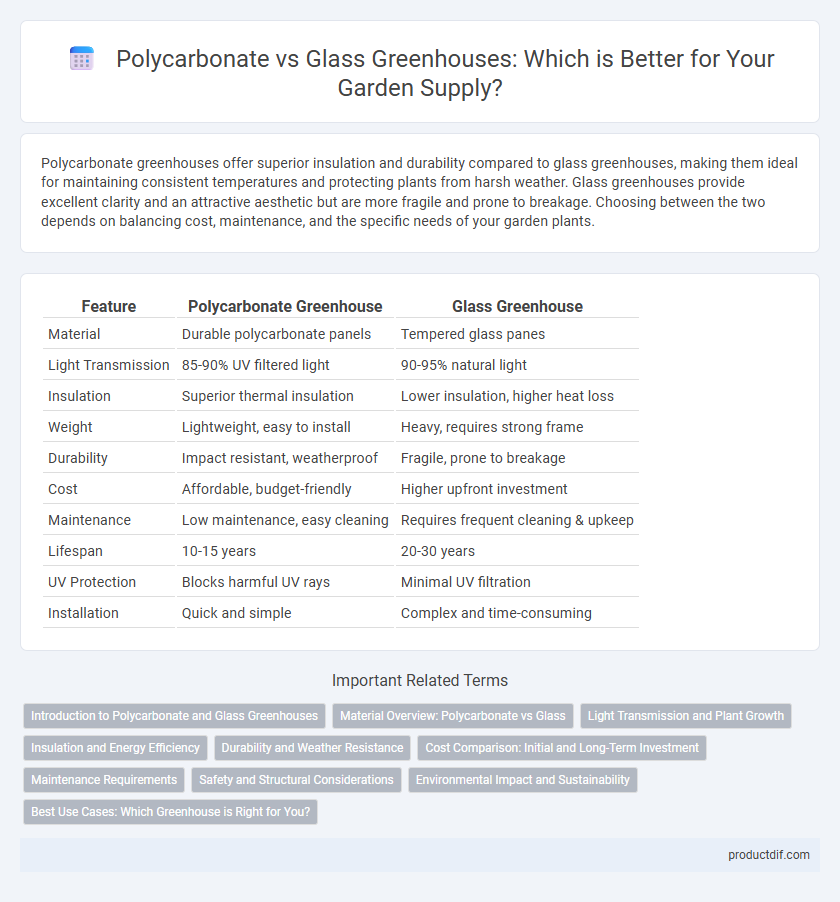Polycarbonate greenhouses offer superior insulation and durability compared to glass greenhouses, making them ideal for maintaining consistent temperatures and protecting plants from harsh weather. Glass greenhouses provide excellent clarity and an attractive aesthetic but are more fragile and prone to breakage. Choosing between the two depends on balancing cost, maintenance, and the specific needs of your garden plants.
Table of Comparison
| Feature | Polycarbonate Greenhouse | Glass Greenhouse |
|---|---|---|
| Material | Durable polycarbonate panels | Tempered glass panes |
| Light Transmission | 85-90% UV filtered light | 90-95% natural light |
| Insulation | Superior thermal insulation | Lower insulation, higher heat loss |
| Weight | Lightweight, easy to install | Heavy, requires strong frame |
| Durability | Impact resistant, weatherproof | Fragile, prone to breakage |
| Cost | Affordable, budget-friendly | Higher upfront investment |
| Maintenance | Low maintenance, easy cleaning | Requires frequent cleaning & upkeep |
| Lifespan | 10-15 years | 20-30 years |
| UV Protection | Blocks harmful UV rays | Minimal UV filtration |
| Installation | Quick and simple | Complex and time-consuming |
Introduction to Polycarbonate and Glass Greenhouses
Polycarbonate greenhouses feature durable, impact-resistant panels that provide excellent insulation and UV protection, making them ideal for year-round gardening. Glass greenhouses offer superior transparency and aesthetic appeal, allowing maximum sunlight penetration for optimal plant growth. Both materials support controlled environments but differ in weight, cost, and maintenance requirements.
Material Overview: Polycarbonate vs Glass
Polycarbonate greenhouse panels offer superior impact resistance and thermal insulation compared to traditional glass, making them ideal for diverse climate conditions. Glass greenhouses provide exceptional light transmission and a classic aesthetic but are more fragile and prone to breakage. Polycarbonate's lightweight and UV-resistant properties ensure long-lasting durability, while glass requires careful handling and higher maintenance.
Light Transmission and Plant Growth
Polycarbonate greenhouses offer diffuse light transmission, reducing hotspots and promoting even plant growth, while glass greenhouses provide clearer, more direct sunlight ideal for light-loving plants. The superior insulation properties of polycarbonate panels help maintain consistent temperatures, enhancing photosynthesis and extending growing seasons. Glass greenhouses excel in maximizing light intensity but may cause uneven heating, which can stress sensitive plants and affect growth uniformity.
Insulation and Energy Efficiency
Polycarbonate greenhouses provide superior insulation compared to glass greenhouses due to their multi-wall construction, which traps heat more effectively and reduces energy loss. This enhanced thermal efficiency leads to lower heating costs and maintains a stable growing environment for plants, even in colder climates. Glass greenhouses, while offering high light transmission, often require additional heating to compensate for their lower insulating properties, making polycarbonate a more energy-efficient choice for sustainable gardening.
Durability and Weather Resistance
Polycarbonate greenhouses offer superior impact resistance and can withstand extreme weather conditions such as hail, heavy snow, and strong winds better than glass greenhouses. The multi-wall structure of polycarbonate panels provides enhanced insulation and durability, reducing the risk of cracking or breaking during temperature fluctuations. Glass greenhouses, while offering excellent light transmission, are more fragile and prone to damage from physical impacts and harsh weather events.
Cost Comparison: Initial and Long-Term Investment
Polycarbonate greenhouses typically require a lower initial investment, with prices ranging from $500 to $3,000 depending on size and quality, compared to glass greenhouses which often start around $2,000 and can exceed $10,000. Polycarbonate panels offer enhanced durability and impact resistance, reducing maintenance and replacement costs over time, while glass structures demand more frequent repairs and risk of breakage that elevates long-term expenses. Energy efficiency also favors polycarbonate, as its insulating properties lower heating costs, whereas glass greenhouses tend to require higher energy inputs to maintain stable growing temperatures.
Maintenance Requirements
Polycarbonate greenhouses require significantly less maintenance than glass greenhouses due to their impact-resistant and UV-resistant panels that do not easily crack or shatter. Glass greenhouses demand regular inspections and repairs for broken panes and frame corrosion, along with frequent cleaning to maintain clarity and light transmission. Polycarbonate's durability reduces replacement costs and upkeep time, making it a more practical option for long-term garden supply needs.
Safety and Structural Considerations
Polycarbonate greenhouses offer superior impact resistance, making them safer in harsh weather conditions compared to fragile glass panels. Their lightweight design reduces structural stress, allowing for easier installation and longevity without heavy support frameworks. Glass greenhouses, while aesthetically pleasing and offering excellent light transmission, require reinforced frames to prevent breakage and pose higher risks during storms or accidental impacts.
Environmental Impact and Sustainability
Polycarbonate greenhouses offer superior environmental benefits over glass greenhouses due to their lightweight durability and energy-efficient insulation properties that significantly reduce heating requirements. The manufacturing process of polycarbonate panels emits fewer greenhouse gases compared to the energy-intensive production of glass, enhancing sustainability. Moreover, polycarbonate materials are often recyclable, contributing to lower waste and a smaller ecological footprint in garden supply projects.
Best Use Cases: Which Greenhouse is Right for You?
Polycarbonate greenhouses excel in durability, impact resistance, and insulation, making them ideal for gardeners seeking energy efficiency and protection in variable climates. Glass greenhouses offer superior light transmission and aesthetic appeal, perfect for hobbyists or commercial growers prioritizing maximum sunlight and a traditional look. Choosing between polycarbonate and glass depends on your climate conditions, budget, and specific gardening goals such as crop type and year-round cultivation.
Polycarbonate Greenhouse vs Glass Greenhouse Infographic

 productdif.com
productdif.com